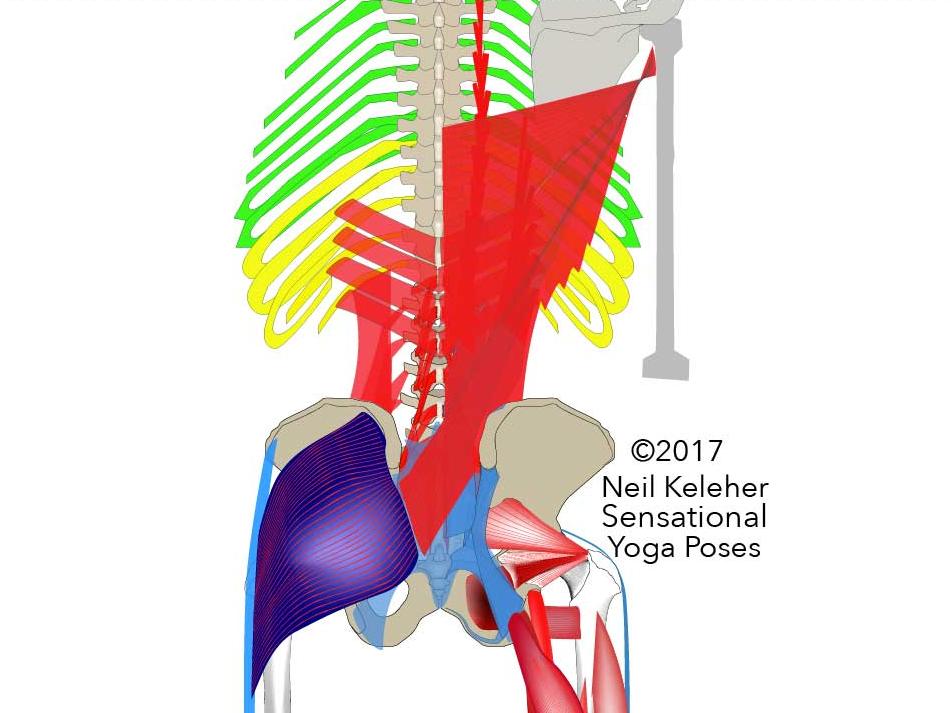Anatomy and Biomechanics of Low Back Stability
How is the lower back stabilized? Why does it matter?
A lot of people know the low back simply because it is a common site for aches and pains.
One reason for learning the anatomy of the lower back, and the biomechanics, is to better understand it. If you understand something you can then look at ways to fix it if something is wrong with it.
Muscles that Attach Directly to the Lumbar Spine
Let's first look at the muscles that attach to the lumbar spine, the part of the spine that connects the pelvis to the ribcage.
A good starting point is the psoas and quadratus lumborum muscles.
The Psoas
Like the piriformis muscle, the Psoas attaches between the leg and the lumbar spine.
- Attaching to the top of the inner thigh at the lesser trochanter, it wraps around the front of the pelvis before reaching back to the lumbar spine.
- It is the only muscle that attaches directly to the bodies of the lumbar spine.
- It also attaches to the transverse process of the lumbar spine, as does the quadratus lumborum.

Psoas Major,
side view
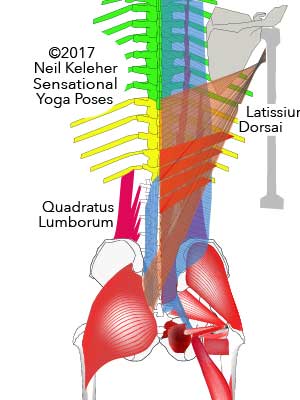
Quadratus Lumborum,
rear view
Stabilizing the Low Back with the Psoas
Because the psoas crosses the hip, its function dependent on what is happening at the hip joint.
With the hip bent forwards, the psoas may not have enough length to contract effectively. And so in forward bends the psoas may not be an effective lower back stabilizer, even if the thigh is stable.
If some muscle of the hip isn't functioning ideally, the psoas may be forced to be active or inactive. If only one hip is affected the psoas on that side can cause an persistant unbalanced force on the lumbar spine.
For the psoas to stabilize the lumbar spine, it needs a stabilized thigh bone (femur). If the thigh is stabilized the psoas has a foundation from which to pull forwards and downwards on the front of the lumbar spine.
Quadratus lumborum
The Quadratus Lumborum fills the gap in the region of the lower back between the bottom most rib (which is also the shortest rib) and the back of the top of the pelvis.
- It attaches from the top of the pelvis to the spinous processes of the upper four lumbar vertebrae.
- It also connects from the back of the pelvis to the lowest pair of ribs.
Stabilizing the Low Back with the Quadratus Lumborum
The quadratus lumborum doesn't cross the hip joint and so isn't directly affected by that joint.
One way to look at this muscle is that it helps to support and stabilize the lower back when the psoas can't.
For the Quadratus Lumborum to stabilize the lumbar spine, it needs a stable pelvis. Note that transverse abdominis activation (below) may help quadratus lumborum activation since it passes behind the quadratus lumborum before attaching to the lumbar vertebrae.
The Transverse Abdominus
The Transverse Abdominus is like a belt that wraps around the waist between the ribcage and pelvis. (It also fills in the gap, the arch at the front of the ribcage and opening at the front of the pelvis).
- At the back of the abdominal compartment it passes behind the quadratus lumborum to attach to the transverse processes of the lumbar spine.

Transverse Abdominus divided into three parts:
Upper, Middle and Lower.
Tension in the transverse abdominus may affect the quadratus lumborum. It may pull inwards on that muscle, adding tension to it. The quadratus lumborum may then be tensioned enough that with a modicum of activation it can then help to stabilize the lumbar spine.
The Paraspinalis Rectinacular Sheath
The transverse abdominus, as it passes behind the quadratus lumborum, forms the front wall of what is called the paraspinalis rectinacular sheath.
This is basically the connective tissue sock that wraps around the spinal erectors and other muscles that act on the back of the spine and back of the ribs. It is part of the thoracolumbar fascia.
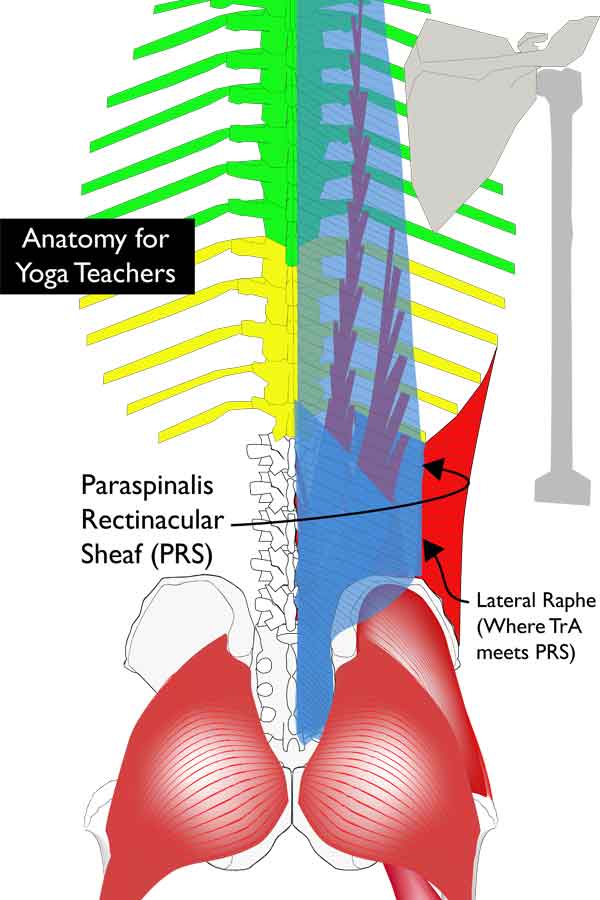
The Paraspinalis Rectinacular Sheath (PRS).
In the lumbar region the Transverse Abdominus forms part of the front wall.
The paraspinalis rectinacular sheath extends downwards beyond the sacrum and upwards into the cervical region.
Activation of the Transverse Abdominus can add tension to the tube of the paraspinalis muscles giving them a foundation from which to act on the back of the sacrum and lumbar spine and even the bottom part of the thoracic spine.
Serratus Posterior Inferior functions
Another part of the thoracolumbar fascia is the Serratus Posterior Inferior muscle.
- This muscle attaches to the lower three or four ribs and from there to the lowest two thoracic vertebrae and the upper two lumbar vertebrae.
The Thoracolumbar Junction is where the ribcage meets the lower back. The serratus posterior inferior can have a strong stabilizing effect on this junction which could be considered the upper part of the lower back.
Working against the upper band of the transverse abdominus muscle, it can help to solidify or brace the solar plexus.
With lifted ribs or ribs stabilized against being pulled downwards, this muscle can work to stabilize the thoracolumbar junction.
Working from a stabilized lumbar spine (stabilized by the quadratus lumborum perhaps, or by the psoas) the serratus posterior inferior anchors the bottom three or four pairs of ribs, helping to resist them being pulled upwards.
Since the latissimus dorsai attach, in part, to the bottom three or four ribs, this action can be used to help anchor the latissimus dorsai.
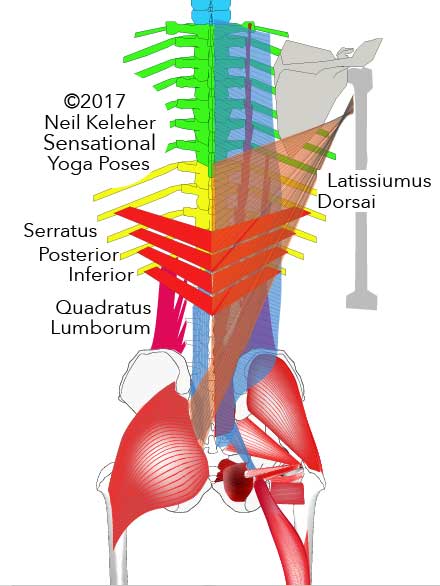
Serratus Posterior Inferior, Latissimus Dorsai and Quadratus Lumborum
Latissimus Dorsai
The Latissimus Dorsai also forms part of the Thoracolumbar Fascia.
The latissimus dorsai has fibers that cross the back of the sacrum to the opposite gluteus maximus. This connection may help in bracing the SI joints.
For it to help stabilize the SI joint, the relevant gluteus maximus fibers could activate and thus act as a foundation for the lats, or the arms could be stabilized and thus act to anchor the lats and thus the glute max.
Note that these fibers, from Latissimus Dorsai to glutes, may or may not be continuous with the Iliotibial Band.
The IT Band
If the feet and shins are stabilized against rotation (while standing) this anchors the bottom end of the IT Band, and possibly also the pes anserinus, the goose foot shaped combined attachment of the Sartorius, Gracilis, and Semitendinosus to the tibia.
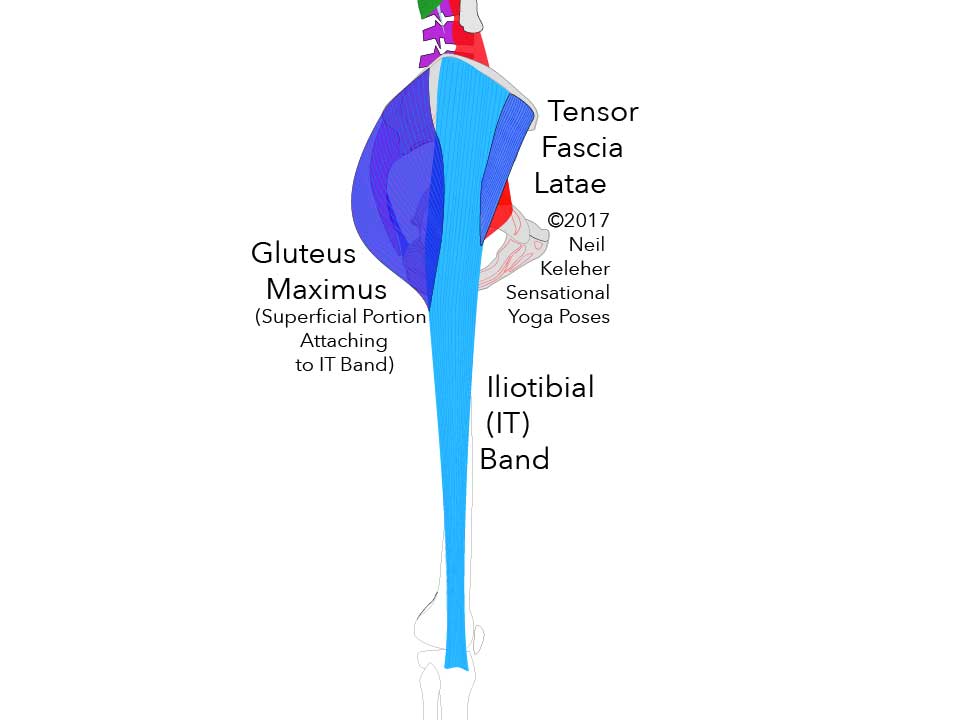
IT Band
(Lateral or outside view of the leg).
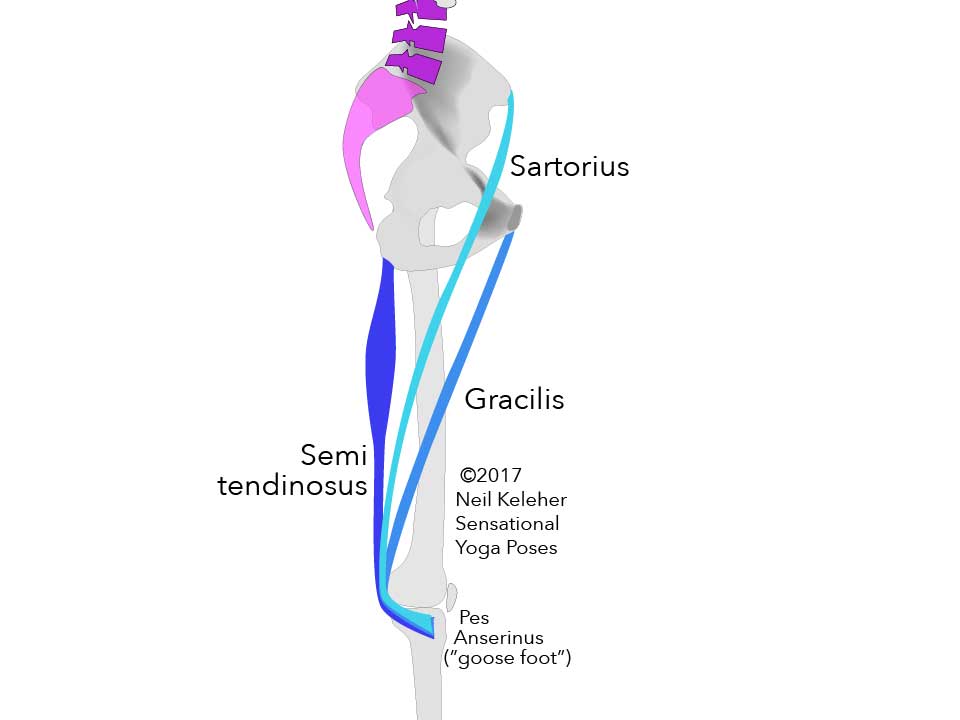
The shared connection of the Sartorius, Gracilis and Semitendinosus at the Tibia is called the
Pes Anserinus or Goose Foot
(Medial or inside view of the leg).
These three muscles all attach at key points of the pelvis.
The muscles that attach to the upper end of the IT band, the superficial fibers of the Gluteus Maximus and the Tensor Fascia Latae also attach to key points of the pelvis.
These key points are at the corners of the pelvis and so these muscles could act together to stabilize the pelvis with minimum effort.
Key Points of the Pelvis
Key or corner points of the pelvis are:
- Point of the Hip Crest/Anterior Superior Iliac Crest (Sartorius, Tensor Fascia Latae)
- Pubic Bone/Pubic synthesis (Gracilis)
- Sitting Bone/Ischial Tuberosity (Semitendinosus)
- Posterior Superior Iliac Crest (Superficial Gluteus Maximus)
If these muscles stabilize the pelvis, or if one hip bone is stabilized via the above muscles, this then gives the quadratus lumborum a stable foundation from which to stabilize the lumbar spine.
Stabilizing the Low Back While Standing
Bearing the above anatomy and biomechanics in mind, the low back can be stabilized by the psoas if the thighs are stabilized. This stability could come all the way from the ground (via the feet and ankles). It could also come from stabilizing the hip joint.
The low back could also be stabilized by the quadratus lumborum if the pelvis is stablized. As with the thigh bone, the pelvis could derive stability from the ground via the lower legs and IT Band. It could also derive stability from stable hip joints. And it could also derive stability by adding tension the midsection. In this case the pelvis is stabilized via the ribcage.
Note that an additional way to stabilize the lower back while standing with knees slightly bent is to shift the ribcage (and head) rearwards relative to the pelvis. If shifted back far enough, the weight of the upper body can press down through the sacrum helping to tilt the pelvis back. This in turn helps to flatten the lower back.
In this position, the psoas is anchored at the lumbar vertebrae by the weight of the upper body pressing down through these vertebrae and the sacrum. This method is an easy way to help stabilize the lower back without excessive effort.
Note that if using this method while standing on one leg then the quadratus lumborum on the unweighted side may need to activate in order to control side-tilt of the pelvis. The idea here is to adjust quadratus lumborum activation and pelvic side tilt so that the pelvis continues to tilt back and the lumbar spine remains relatively flat.
Published: 2020 08 15
Updated: 2023 03 23
